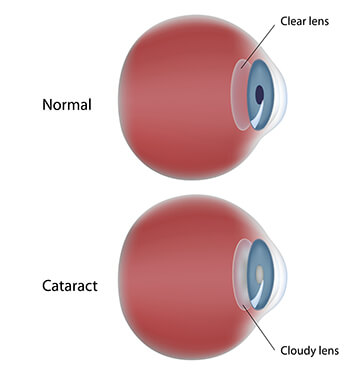
Is your vision hazy, blurry, or cloudy? These are often the first signs of cataracts.
The eye doctors at Colorado Eye Consultants in Littleton have extensive experience treating cataracts and performing cataract surgery.
Cataracts occur when the clear lens of the eye becomes cloudy. For many people, it can feel like looking through a fogged-up window.
When cataracts cloud your vision, it is difficult to read or drive a car, especially at night. Cataracts are usually small when they first develop but grow larger slowly over time.
You may notice that objects look blurry or hazy with a cataract. Most people that have cataracts will eventually need to have cataract surgery.
If your cataracts aren’t treated, they will block more and more light from entering your eye. This causes vision loss, and ultimately, blindness.
Our experienced eye surgeons can remove your cataracts and replace them with fully functional artificial lenses.

There are many symptoms of cataracts. You may experience the following vision changes:
If you notice any of these symptoms, call the experienced eye doctors at Colorado Eye Consultants. Some of these symptoms can overlap with other more serious eye conditions.
The most common cause of cataracts is aging. This may occur due to normal eye changes that happen starting around the age of 40.
By the age of 60, it is common for people to have some clouding in their lenses. At this point, proteins in the lens may start breaking down.
You may also be more likely to develop cataracts if you have family members with them. Other factors that may lead to the development of cataracts include:
There is no way to guarantee you’ll never develop cataracts. Living a healthy lifestyle can make you less likely to develop them earlier.

Intraocular lenses, or IOLs, are artificial lenses used during cataract surgery. They replace the natural cloudy lens of your eyes once cataracts have developed.
You will not feel the IOL once it’s implanted in your eye. It becomes a permanent part of your eye.
Its job is to make sure that light can enter the retina of your eye to keep your vision clear. IOLs are a safe and practical way to restore vision through cataract surgery.
Your doctor will help you decide what IOL is right for you. There are several kinds of IOLs, including multifocal, accommodating, monofocal, trifocal, and toric.
The ORA™ system allows your cataract surgeon to choose which IOL power is best suited in order to achieve the most optimal surgical outcome. ORA™ cannot predict a patients outcome with 100% certainty but it does help to maximize the best potential vision for patients with a history of refractive surgery, such as LASIK, PRK, or RK. Patients who have previously had refractive surgery, often have a less predictable surgical outcome because the cornea has been altered, making it more difficult for a surgeon to know exactly which IOL power is best suited for the targeted outcome. The ORA™ system utilizes real-time wavefront aberrometry data to measure and analyze the refractive power of the eye thereby providing your surgeon with on-demand ability to make any necessary IOL power adjustments. ORA™ technology is considered to be one of the most dramatic breakthroughs in cataract surgery over the past two decades.
Standard cataract surgery involves placing a monofocal lens into the eye. This kind of intraocular lens can only correct one focalus point of distance.
That focal point can is is either be for distance vision, intermediate vision, or near vision. If you choose this kind of IOL, you will need to wear reading glasses to see at other ranges. distances.
Some patients choose to have a lens implanted for distance vision in one eye and near vision in the other. This is a method known as monovision.
This is not recommended for everyone. Discuss whether monovision is right for you with your eye doctor.
This is one of the newest state-of-the-art IOLs available. Multifocal IOL’s are the latest innovation in intraocular lenses and provide patients a broader depth of focus, allowing them to see at various ranges without being dependent on galsses.Your eye doctor may recommend this IOL because it corrects the full range of vision. Patients with an active lifestyle might be a good candidate for a multifocal IOL. You eye doctor will let you know if it may be right for you.
This includes both distance vision and near vision. Most patients that choose this kind of IOL no longer need to wear glasses or contact lenses for most activities after cataract surgery.
With accommodating IOLs, there is only one focusing distance on the lens. Though you can’t see several different focusing distances with this lens, this IOL allows your lets your eye to change its focal point at various distances when you look at something far away or up close.
This does not result in a loss of quality in your distance vision, which you could experience with a multifocal lens. To see something that’s very close distance or fine detail, you may still need reading glasses to compensate.
With the newly introduced trifocal lens, patients can easily see up close, far away, and at an intermediate distance. Unlike some multifocal IOLs, there is no gap in vision.
Trifocal IOLs are often best for people that complete tasks at an intermediate distance, which is an arm’s length away. This includes working a lot on the computer, using a smartphone to text, or reading menus at a restaurant.
For patients with astigmatism, toric IOLs are the only lens specifically designed to correct it. These lenses correct moderate to high astigmatism.
They may be monofocal – to correct either distance or near vision – or multifocal, to correct both distance and near vision. These options should be discussed with your surgeon.
If you have astigmatism, it means the cornea and/or the lens of your eye has an irregular curvature and the eye is shaped more like a football than round like a basketball. If you are a cataract patient, your surgeon can eliminate your astigmatism with a procedure that can be done at the same time of as cataract surgery in a number of different ways depending on the amount and whether it is regular or irregular astigmatism. Correcting astigmatism at the time of cataract surgery this will result in a better quality of vision both with and without glasses.
One option is a procedure where your eye surgeon creates a pair of incisions in the corneal limbus. To fix the irregular curvature, they’ll vary the length, depth, and location of the incisions.
They are called Limbal Relaxing Incisions (LRI). This can be effective, but there also are other options.
Laser Enhancement Surgery may help restore vision for patients with high astigmatism. It can also be combined with LRI and a toric lens to give you the best vision possible.
Laser enhancement surgery is high-precision surgery that has the highest success rate of correcting high astigmatism. It has a higher rate of success over implants or incisions.
This may be an option for patients who want multifocal IOLs. You cannot have laser enhancement surgery until at least six weeks after cataract surgery. There is also an extra cost for this procedure.
If you have cataracts, they will not go away on their own. The only way to treat them and regain clear vision is with cataract surgery.
At first, you may be able to manage them using stronger lighting and glasses. Eventually, your vision will become impaired, interfering with your usual activities.
Cataracts are the leading cause of blindness in the world. Fortunately, cataract surgery is common, safe, and effective for restoring vision.
Cataract surgery involves removing the clouded natural lens of the eye and replacing it with a clear artificial lens.
Before cataract surgery, you will receive a comprehensive eye exam from one of our board-certified ophthalmologists. Your doctor will check the health of your eyes.
They will also identify any risk factors before scheduling your surgery. Your eye exam will help determine the amount of nearsightedness, farsightedness, or astigmatism before surgery.
Your doctor also will take measurements of your eyes to find out the length and curvature of your eye. This will help your surgeon select the proper intraocular lens to give you the best possible vision after surgery.
During cataract surgery, you will be given a local anesthetic. The surgery usually lasts 20 to 30 minutes.
The most common form of cataract surgery is routinely performed by using phacoemulsification. This uses a small probe and ultrasound waves to gently break up the lens. With this method, the lens is gently first removed and replaced with an IOL that you and your surgeon have decided is best for you. Then the IOL is put into place.
The second method of cataract surgery can also be performed utilizing a laser is also known as laser-assisted cataract surgery. This method uses a femtosecond laser to make incisions and replace the need for blades during cataract surgery.
After cataract surgery, you can go home the same day, but you will need someone to drive you home as you cannot drive the day of your surgery. Many patients see well enough to drive the following day but it can take several days or weeks for the vision to clear depending on other eye-related issues patients may have. Expect to come in the next day for your first follow-up appointment.
This will allow your eye doctor to check how your eye is healing. Part of the healing process requires you to use eye drops to prevent infection and inflammation.
Patients usually notice an almost immediate improvement after cataract surgery. If a patient has cataracts in both eyes, the doctor will operate on one eye first.
The timing of the surgery on your second eye will be weeks or months later will be determined by you and your surgeon. You may still need glasses after cataract surgery depending on the IOL you choose.
Not sure if you may have cataracts? Schedule a cataract screening at Colorado Eye Consultants in Littleton, CO today!
Colorado Eye Consultants is dedicated to the preservation of sight and providing patients with the quality of life they deserve. Our patients receive personalized care by knowledgeable and experienced board certified ophthalmologists to ensure the clarity needed to see the most important things in their world. Your vision is our utmost priority and we offer same day appointments to ensure you get the care you deserve!
Request an Appointment